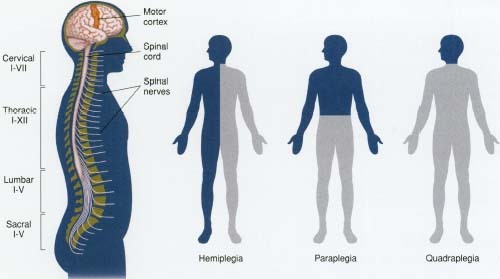Hemiplegia
From Psy3242
(→Types of Hemiplegia) |
|||
| Line 23: | Line 23: | ||
• spinal hemiplegia – caused by lesions on the spine. | • spinal hemiplegia – caused by lesions on the spine. | ||
| - | |||
| + | Alternating hemiplegia is a rare type of hemiplegia that usually develops in children during their first four years. Characterized by repeated, although temporary, incidences of paralysis on one side of the body. The paralysis can affect anything from limbs to facial muscles. One form of this particular type of hemiplegia has been found to occur largely at night while the child is awake. New research has shown that this form maybe linked to migraines. Children affected with this order do not usually have any other impairments, but serious cases have shown there to be mental impairment, difficulty with balance, excessive sweating, and seizures can occur. Although sleep temporary relieves the paralysis, it usually recurs upon waking up. | ||
== Recovery == | == Recovery == | ||
Revision as of 16:03, 14 April 2008
Contents |
Overview
Hemiplegia describes the condition of a brain damaged individual who is unable to intentionally move parts of his or her body on the side opposite that of the brain damage. The affected hemisphere may be completely paralyzed or simply weakened. Other characteristics of hemiplegia include limited use of one hand, and/or balancing, speech and visual field problems. Hemiplegia usually occurs as a result of a loss of blood supply in the mid-cerebral artery due to aneurysm, hemorrhage, or clot. It may also be caused by a head injury, epilepsy, and/or tumor. In addition, damage to sub-cortical structures, such as the basal ganglia, may result in hemiplegia, since such structures are often served by the mid-cerebral artery.
Types of Hemiplegia
The types of hemiplegia include:
• facial hemiplegia – paralysis of one side of the face
• cerebral hemiplegia – caused by brain lesion which inhibits blood flow
• spastic hemiplegia – paralysis as well as convulsive movements of the affected side, occurs mostly in infants
• spinal hemiplegia – caused by lesions on the spine.
Alternating hemiplegia is a rare type of hemiplegia that usually develops in children during their first four years. Characterized by repeated, although temporary, incidences of paralysis on one side of the body. The paralysis can affect anything from limbs to facial muscles. One form of this particular type of hemiplegia has been found to occur largely at night while the child is awake. New research has shown that this form maybe linked to migraines. Children affected with this order do not usually have any other impairments, but serious cases have shown there to be mental impairment, difficulty with balance, excessive sweating, and seizures can occur. Although sleep temporary relieves the paralysis, it usually recurs upon waking up.
Recovery
Hemiplegic Individuals are usually able to improve over time. Changes in bloody supply as well as blood loss result in cell death and loss of function in adjacent neurons. Most of these neurons are later able to return to a normal or near normal functioning level thereby allowing for the patient to have at least a partial behavioral recovery of function. Many patients have also proven to be adaptable by learning new ways of moving by using different brain regions.
Anosognosia in Patients with Hemiplegia
Anosognosia, a condition in which patients are unaware of his or her illness and/or the effects of that illness, occurs in approximately fifty percent of hemiplegics. These patients do not believe they are paralyzed at all and often overestimate their abilities thereby making them less likely to regain independence after their strokes than non-anosognosia hemiplegics.
Resources
- NIH site
- Online encyclopedia site
- [1]
- Stirling, John. Introducing Neuropsychology
- Ogden, Jenni A. Fractured Minds: A Case Study Approach to Clincial Neuropsychology

